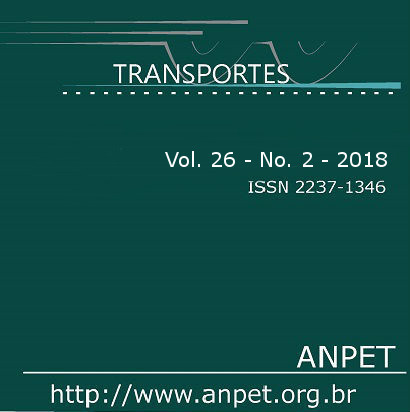Determinação do dano em pavimentos asfálticos por meio da combinação do modelo S-VECD com análises elásticas
DOI:
https://doi.org/10.14295/transportes.v26i2.1446Keywords:
Design, Asphalt pavements, Fatigue, Damage.Design, Damage.Abstract
Performance prediction of materials in the field is one of the challenges in pavement engineering. Such prediction requires mathematical modeling that relates materials characterization in the laboratory and the performance of these same materials in actual structures. Since fatigue damage is one of the main distresses in Brazilian asphaltic pavements, the objective of this work is to present a methodology to determine such distress using linear elastic analysis, having as inputs fatigue damage evolution parameters obtained in laboratorial tests. Given the importance of temperature and vehicle speed in roadways for pavement performance with respect to fatigue damage, these two parameters are also considered in the simplified analysis. At the end, it is presented a practical example with the main steps of the developed methodology, which is programmed in a specific pavement design software. The proposed methodology is a step in enhancing field-laboratory correlation, facilitating the behavior prediction of asphaltic materials in real pavements.Downloads
References
Babadopulos, L. F. A. L.; J. B. Soares; V. T. F. Castelo Branco e F. V. Souza (2013) Aplicação de análogos mecânicos para representar o comportamento viscoelástico linear de misturas asfálticas e interpretar sua influência no módulo de resiliência. In: XVII Congresso Ibero-Latinoamericano del Asfalto, Guatemala.
Babadopulos, L. F. A. L.; J. B. Soares; V. T. F. Castelo Branco (2015) Interpreting fatigue tests in hot mix asphalt (HMA) using concepts from viscoelasticity and damage mechanics. Revista Transportes v. 23, n. 2, p. 85-94. ISSN: 2237-1346 (online). DOI: 10.14295/transportes.v23i2.898.
Fritzen, M. A. (2016) Desenvolvimento e Validação de Função de Transferência para Previsão de Dano por Fadiga em Pavimentos Asfálticos. Tese (Doutorado em Engenharia Civil) COPPE/UFRJ. Rio de Janeiro.
Gouveia, B. C. S. (2016) Validação de modelos de previsão de módulo dinâmico para misturas asfálticas aplicadas em rodovias brasileiras. Dissertação (Mestrado em Engenharia de Transportes) – Centro de Tecnologia, Universidade Federal do Ceará, Fortaleza.
Holanda, A. S.; E. Parente Jr.; T. D. P. Araújo; L. T. B. Melo; F. Evangelista Jr. e J.B. Soares (2006). Finite Element Modeling of Flexible Pavements. XXVII Iberian Latin-American Congress on Computational Methods in Engineering (CILAMCE). Belém, Pará.
Huang, Y. H. (2004) Pavement Analysis and Design. 2ª edição. Ed. Pearson prentice Hall. ISBN: 0-13-142473-4. USA.
Kim, Y. R. (2009) Modeling of Asphalt Concrete. American society of Civil Engineers. Ed. Mc Graw Hill Construction. ISBN: 978-0-07-146462-8. USA
Lemaitre, J. (1996) A Course on Damage Mechanics. 2ªEdição. Ed. Springer. ISBN-13: 978-3540609803.
Mello, L. G. R.; M. M. Farias; E. S. Preussler e R. Preussler (2016) Análise do impacto do período de projeto de pavimentos no custo global de obras rodoviárias. Revista Transportes v. 24, n. 4, p. 64-74. ISSN: 2237-1346 (online). DOI: 10.14295/transportes.v24i4.1056.
Motta, L.M.G. (1991) Método de Dimensionamento de Pavimentos Flexíveis; Critério de Confiabilidade e Ensaios de Cargas Repeti-das. Tese (Doutorado em Engenharia Civil). COPPE/UFRJ, Rio de Janeiro.
Nascimento, L. A. H. (2015) Implementation and Validation of the Viscoelastic Continuum Damage Theory for Asphalt Mixture and Pavement Analysis in Brazil. Tese (Doutorado Civil Engineering). North Carolina State University. Raleigh-USA.
Nascimento, L. A. H. (2016) Apresentação realizada no Departamento de Engenharia de Transportes na Universidade Federal do Ceará. Data: 21 de dezembro de 2016. Fortaleza-Ce.
NCHRP (2004) Guide for Mechanistic-Empirical Design of new and Rehabilitated Pavement Structures. Final Report. Part 3: Design Analysis. Chapter 3: Design of new and reconstructed flexible pavement. National Cooperative Highway Research Program – NCHRP. Illinois-USA.
NCSU (2014) Layered Viscoelastic Pavement Analysis for Critical Distresses – LVECD 1.0 Beta (User Guide). Department of Civil, Construction, and Environmental Engineering. North Carolina State University.
Shah, S. P.; S. E. Swartz e C. Ouyang (1995) Fracture Mechanics of Concrete: Applications of fracture Mechanics to Concrete, Rock and Other Quasi-Brittle Materials. Ed. Wiley Interscience. New York- USA. ISBN: 0-471-30311-9.
Torquato e Silva, S. A.; P. J. F. Vidal; A. S. Holanda e E. Parente Júnior (2013) Análise viscoelástica de pavimentos asfálticos utilizando elementos finitos e infinitos. Revista TRANSPORTES, v. 21, n. 3, p. 5-13. ISSN: 2237-1346 (online). DOI: 10.4237/transportes.v21i3.676.
Downloads
Published
How to Cite
Issue
Section
License
Authors who submit papers for publication by TRANSPORTES agree to the following terms:
- The authors retain the copyright and grant Transportes the right of first publication of the manuscript, without any financial charge, and waive any other remuneration for its publication by ANPET.
- Upon publication by Transportes, the manuscript is automatically licensed under the Creative Commons License CC BY 4.0 license. This license permits the work to be shared with proper attribution to the authors and its original publication in this journal.
- Authors are authorized to enter into additional separate contracts for the non-exclusive distribution of the version of the manuscript published in this journal (e.g., publishing in an institutional repository or as a book chapter), with recognition of the initial publication in this journal, provided that such a contract does not imply an endorsement of the content of the manuscript or the new medium by ANPET.
- Authors are permitted and encouraged to publish and distribute their work online (e.g., in institutional repositories or on their personal websites) after the editorial process is complete. As Transportes provides open access to all published issues, authors are encouraged to use links to the DOI of their article in these cases.
- Authors confirm they have obtained all required employer permissions for the publication and CC BY 4.0 licensing of the manuscript, particularly if the employer holds any claim to the manuscript's copyright. Authors assume all responsibility for employer-related copyright issues, releasing ANPET and Transportes from any related liability.
- Authors assume full responsibility for the content of the manuscript, including the necessary and appropriate authorizations for the disclosure of collected data and obtained results, releasing ANPET and Transportes from any responsibility in this regard.
Last update: 11/27/2025











